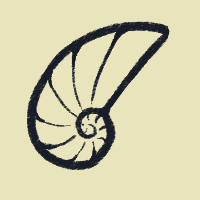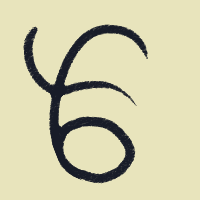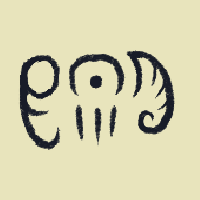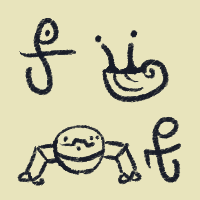City Sigils
While the bugkin have never been able to access true magic, their myths and fables are rife with them, often in the form of sigils. Sigils are a relic of an older time, once designed to beseech spirits to protect homes, families, or entire cities, but which now survive mostly as symbols of identification or decorative elements. City sigils can be found in offices and on supply crates, in transit stations and in private homes, in art and in literature. Some symbols are created wholesale and designed to reflect the modern city, while others are modifications of ancient markings altered for better recognizability and replication. Here is only a sampling.

The city of Tidewatch has used mollusk shells to represent the city for centuries, a tradition that has its roots in the city’s founding myth. However, for most of the city's history this iconography was non-standardized, with many organizations and businesses using unique and highly ornate designs, some of which survive to the modern day. The current symbol of a segmented snail shell is only a few decades old, and not without detractors. The oldest known instances of the Tidewatch sigil are not depictions of a shell, but are instead abstract symbols carved into shells which would be placed into the foundations of protected buildings. The use of physical seashells in Tidewatch architecture continues to this day.

The sigil of Godsfall is one of the oldest still in modern use, but it has not survived unaltered. While modern sigils are typically representational, older designs are more abstract, utilizing obscufation to hide their true, sacred meaning from the masses. Over time, the already-abstract sigil of Godsfall was altered as the initial meaning was forgotten. Citizens can only speculate on what the design once was and what it meant. Some compare it to the vertebrate bones which originally formed the basis of the city, while others liken the design to the husk of a bug. It is likely this speculation will continue for as long as Godsfall stands.

The city of Marrowhaven is a small one, founded by former residents of Godsfall once the city’s reserves of marrow were depleted. Located among the bones of a long-dead herd of beasts, the city has long had a fascination with vertebrates and skeletons. For the sigil’s designer, Quercus of North Marrowhaven, the choice seemed obvious. In an artist’s statement, she stated: “Some criticized it for a lack of subtlety, but I think they’re too focused on what certain other citys' have for a sigil. It’s easy to get in your head, this is what a sigil should be, but lots of cities have clear-cut symbolism. We don’t have to reflect what Godsfall did. We’re our own city and this is our culture.”

The city of Burrowhill is much newer than Godsfall or Tidewatch, but its sigil is very much based in the abstract traditions of the former. Designed by an anonymous artist, the meaning of the sigil has been debated since its adoption yet never reached the fervor surrounding the Godsfall sigil. Many citizens of Burrowhill instead believe that the piece never had any meaning to begin with and was simply designed this way to remind the viewer of ancient designs. In any case, it has remained reasonably popular and relatively unchanged.

The city of Leviathan IV is an unusual one. The fourth incarnation of an experimental “walking city”, the entire populace lives within a colossal (and highly crowded) mecha which slowly wanders the land. Because of the difficulty in establishing regular communication and the constantly-shifting set of neighbors (many of which despise Leviathan IV for the noise and pollution produced), the city remains culturally isolated even today. This isolation was the reason why the sigil designers deliberately rejected tradition in creating their city’s symbol, and produced perhaps the most controversial design of any major city. Online, there are active debate threads that began with the sigils reveal, and continue today.

The concept of city sigils developed before the advent of the internet, when cities and nation-states were relatively isolated. But as cities became connected along regional lines, alliances began to form. While belief in the power of sigils was already waning, the symbols themselves were regularly used to represent the cities; it was only natural that allied cities would symbolize their newfound connections with combinations of their sigils. This was a brief trend; most were considered rather ugly by the populace and thus rarely used outside official documents. While few of these alliance symbols survived long-term, there was one that saw use even outside its intended meaning.
The alliance between the city of Godsfall and Burrowhill was an odd but not unexpected arrangement. While not direct neighbors, the two cities had a long and peaceful history, making the arrangement obvious. But the addition of Grandtide into the alliance surprised many, as did the addition of its sigil to their own. The new sigil, which modified its constituents to better resemble an insect, proved to be remarkably popular; even when more cities were added to the alliance in the following years, the symbol remained unchanged.
But the growing internet was not the only reason why cities were willing to join the growing alliance. Because at the same time, the mages were in the middle of a technological renaissance of their own. Mage villages popped up all across the hinterlands and mountains, and more bugkin resources were spent to monitor and guard against them. As fear boiled and new information about their neighbors spread, the bugkin began to focus less on their cross-city conflicts and more on their distant neighbors to the west. Eventually, the symbol of the great alliance, now called the Crossroads Sigil, drifted away from representing the increasingly-large alliance and instead towards representing all bugkin. Even as the importance of alliances faded, the symbol remained popular.

But cities are vast, and no populace is a monolith. When people feel distant from their neighbors, the powers that be, or the city as a concept, they make their own identities. And for some they define themselves in how they are different from their homeland. For these citizens, “mutated” symbols provide a useful way to express their feelings. Used by groups or individuals, representing distinct factions or vague ideologies, these altered sigils can represent nearly any position on any issue and may mean different things to different people. Trying to explain all would be impossible; here is merely a sample.
---~<*>~--~<*>~---~<*>~---
To return to the Cordhan index, click here.
To return to the homepage, click here.